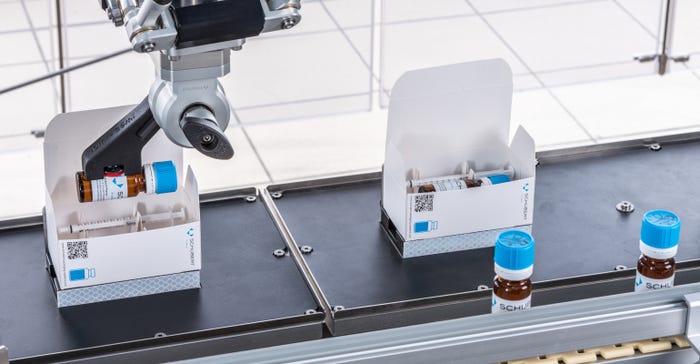Danish pharmaceutical company Lundbeck installed a new packaging line that processes 17 formats of ampoules and vials while working around physical restrictions in the plant.

To modernize the packaging of its medication for neurological diseases, Danish pharmaceutical company Lundbeck was looking for a new packaging automation system for ampoules and vials. In the bidding process, Schubert-Pharma, the Schubert Packaging Systems business unit that specializes in serving the pharmaceutical industry, emerged as the winner with a fully integrated turnkey solution.
Because the new pharmaceutical packaging machine was to replace a previous line, all products were already established on the market. In other words, the machine-compatible packaging for the medication with all the folding chutes and compartments already existed and did not need to be developed. This accelerated the bidding process to just four months before the contract was awarded to Schubert Packaging Systems.
When it came to the requirements for the new pharmaceutical packaging machine, it was especially important for Lundbeck to be able to work without large buffers in front of the packaging area that would slow down line clearance. To save time, only a few products could be in transit between the pre-process and packaging. Conventional feeding technology for the pharmaceutical products was therefore out of the question.
Pharmaceutical packaging machine as a turnkey project.
To set up the entire packaging process as efficiently and securely as possible, Schubert-Pharma supplied a fully integrated line. All pharmaceutical packaging machine components were procured by Schubert and processed as a turnkey solution. The line now includes a Schubert cartoner, a Bausch+Ströbel labeler, and a Pester bander, carton packer, and palletizer.
Schubert-Pharma solved the challenge of feeding ampoules and pipettes with piece-by-piece accuracy up to the point of loading the boxes by means of a small buffer (an accumulation of less than one minute when the line runs at full speed) and the Beckhoff XTS transport system. Thanks to the flexible design of the transport system, the pillars at Lundbeck’s installation site were no longer an obstacle.
The chosen U-shape for the pharmaceutical packaging machine allows Lundbeck to implement the entire process in a single solution. This includes labeling the product, packing it into cartons, applying the banding, packing it into shipping cases, and palletizing it in the production hall. Schubert also developed a universal erecting process for the various inner compartments, which is independent of the format and therefore does not take up any time when the format needs to be changed.
Flexible and process-safe packaging solution in a single line.
The pharmaceutical packaging machine is designed to pack ampoules of two different sizes into boxes of one, two, five, or 10 pieces each. Furthermore, vials, some with pipettes, are packed individually into boxes of four different sizes. Separator inserts or inner compartments are used with all formats to protect the glass bottles from damage. A leaflet or booklet is also enclosed with each box, which is then labeled.
The entire process in the pharmaceutical packaging machine, from erecting the cartons and the inner compartments, to loading the pharmaceutical products and package inserts, to closing and labeling, is handled with the aid of the Transmodul transport robot. This creates a secure, closed packaging process. Schubert’s experience in the pharmaceutical sector and advanced robot technology ensures that all product and packaging tolerances in the specification are met.
Bulk processing of individual containers.
A special feature of the pharmaceutical packaging machine is the feeding of the ampoules from the labeler and the pipettes from the sorting bowl: The XTS feed system from Beckhoff delivers the products quickly and accurately from the pre-machines to the cartoner’s loading area. Even short buffering is possible with the process-safe feed. Thirty small, independent transport modules called movers travel along the rail-based system. They are equipped with corresponding format parts for transporting the ampoules and pipettes.
After automatic separation, five products each are loaded into a mover. Then eight movers group up at the Schubert cartoner’s loading robot. The robot’s tool can pick up 40 ampoules or pipettes all at once and pre-group them into groups of 10. From these pre-groupings, another robot then takes the required number of boxes waiting in parallel on the Transmodul. The labeled vials are then placed individually into the boxes. After the package inserts have been added, the cartons are closed and labeled. Thereafter they run into a banding machine, a case packer, and finally to a palletizer.
The new pharmaceutical packaging line processes a total of 17 formats and delivers an output of up to 420 products per minute. Thanks to the line’s modular design and optimized carton-forming process, a formal changeover takes only 30 minutes. The packaging line’s flexibility has given Lundbeck a significant competitive advantage in the market.
About the Author(s)
You May Also Like




